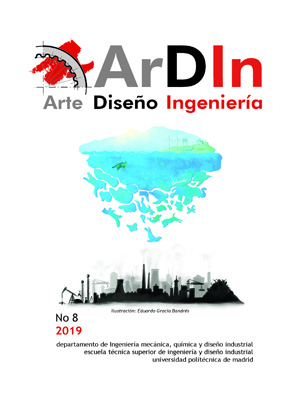El proceso de creación del Arte digital = The Creation Process in Digital Art
DOI:
https://doi.org/10.20868/ardin.2019.8.3866Keywords:
Arte-digital, proceso, creación, México, Digital-art, Process, Creation, MexicoAbstract
Resumen
Este artículo presenta un análisis de los procesos de creación de una selección de artistas digitales —o artistas que hacen uso de la tecnología con obras digitales- mexicanos, desde la óptica de las fases del proceso de creación, a saber, preparación, incubación/intuición, evaluación, elaboración y comunicación. Para tal fin, se realizaron una serie de entrevistas a los artistas de la muestra, donde se indagó sobre sus procesos de producción, dando como resultado una visión comparativa de dichos procesos, así como el análisis derivado de los mismos. Lo anterior con el propósito de, por una parte, comprender los procesos, así como el Arte digital, que, si bien no es un ámbito nuevo, comúnmente se tiene poca familiaridad con el mismo. El estudio de los procesos de producción a través de las fases del proceso de creación aquí presentadas, ofrecen una aproximación distinta al Arte digital, de tal manera que, a través del mismo se busca contribuir a ampliar los límites del conocimiento en torno al Arte digital y sus artistas, así como arrojar luz a los procesos de creación artística que usualmente se llevan a cabo en el ámbito de lo privado.
Abstract
This article shows an analysis of processes of creation of several digital artists and artists who use various forms of art and technology in Mexico. There are different points of view that we can adopt to do this, but we are going to use the five stages of creation processes (preparation, incubation-intuition, evaluation, elaboration and communication), because brought a new approach to this research. For that purpose, special interviews have been made focus on the processes of production of some of the artistic processes, as a consequence, it was possible to compare the results to categorize and perform the analysis of them, aiming the comprehension of the processes and the artistic works of the Digital Art realm. We know the Digital Art begin around the sixties, because of that it is not a new form of art, but still is an original form of art. That is why this research explores Digital Art through the processes of creation and production as a way to contribute to the knowledge of Digital Art, their artists and the processes that commonly take place privately.
Downloads
References
Austin, J.H. 1978:Chase, chance and creativity. Nueva York, Columbia University Press.
Csikszentmihalyi, M. 2007:Fluir (flow) Una psicología de la felicidad. Barcelona, Editorial Kairos. 1996:Creatividad, el fluir y la psicología del descubrimiento y la invención. Barcelona, Paidós.
Gardner, H. 1995:Mentes creativas una anatomía de la creatividad. Barcelona, Paidós.
Lieser, W. 2009: Arte digital. Colonia, H. F. Ullman. 2010: Arte digital, nuevos caminos en el arte. Potsdam, H. F. Ullmann.
Lozano-Hemmer. R. 2000: Alzado Vectorial, Arquitectura Relacional No. 4. Ciudad de México, Consejo Nacional para la Cultura y las Artes.
Marina, J. A. 2006:Teoría de la inteligencia creadora. Barcelona, Anagrama.2004: Elogio y refutación del ingenio. Barcelona, Compactos Anagrama.
Maslow, A. 2005: La personalidad creadora. Barcelona, Kairos.
Paul, C. 2008: Digital Art. 2a. Ed. Londres: Thames & Hudson.
Popper, F. 1993: Art of the electronic age. Nueva York, Thames & Hudson.
Rafols, R. 2003: Diseño audiovisual. Barcelona, Gustavo Gili.
Rodríguez, M. 1985: Manual de Creatividad. Los procesos psíquicos y el desarrollo. Ciudad de México, Editorial Trillas.
Romo, M. 1997: Psicología de la creatividad. Barcelona, Paidós.
Rush, M. 2005: New media in art. Londres, Thames and Hudson.
Shanken, E., 2009: Art and electronic media. Londres, Phaidon.
Tatarkiewicz, W. 2002: Historia de seis ideas. Madrid-Tecnos/Alianza.
Wands, B. 2007: Art of the digital age. Nueva York, Thames y Hudson.
Downloads
Published
Issue
Section
License
ArDIn does not charge authors for processing or publishing an article and provides immediate Open Access to its content. All content is available free to the user or their institution. Users are permitted to read, download, copy, distribute, print, search or link to the full text of articles, or use them for any other lawful purpose, without prior permission from the publisher or author. This is in accordance with the BOAI definition of open access.
- Authors retain the copyright and grant to the journal the right to a Creative Commons attribution / Non-Commercial / Non-Derivative 4.0 International (CC BY NC ND) License that allows others to share the work with an acknowledgement of authorship and non-commercial use.
- Authors may separately establish additional agreements for the non-exclusive distribution of the version of the work published in the journal (for example, placing it in an institutional repository or publishing it in a book).
Unless otherwise indicated, all contents of the electronic edition are distributed under a Creative Commons license.













